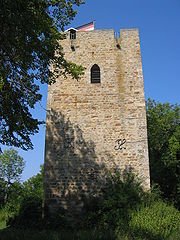
Ruine Achalm
Encyclopedia

Reutlingen
Reutlingen is a city in Baden-Württemberg, Germany. It is the capital of the eponymous district of Reutlingen. As of April 2008, it has a population of 109,828....
and Pfullingen
Pfullingen
Pfullingen is a town in the district of Reutlingen, Baden-Württemberg, Germany. It is situated 3 km southeast of Reutlingen at the foot of the Swabian Alb....
in Baden-Württemberg, Germany. Situated on the top of a hill at the edge of the Swabian Alb
Swabian Alb
The Swabian Alps or Swabian Jura is a low mountain range in Baden-Württemberg, Germany, extending 220 km from southwest to northeast and 40 to 70 km in width. It is named after the region of Swabia....
the ruins of the 11th Century castle are topped by a look-out tower from 1838.
History
Achalm Castle was built around 1030 by Gaugraf Egino and Rudolf of Achalm. The name Achalm appears to refer to a nearby stream, the Ach which comes from the River Alm. According to legend, the name of the castle comes from another source. As the castle was under construction two workers began to fight. Egino separated the two and locked one of them in the castle dungeon. The prisoner soon escaped and when he saw Egino, stabbed him. As he lay dying, his last words were Ach Alm meaning to say Ach Allmächtiger (English: Oh! Almighty (God)). His brother, thinking he was honoring his last words named the castle Achalm.
Elder House of Welf
The Elder House of Welf was a dynasty of European rulers in the 9th through 11th centuries to 1055. It consisted of two groups, a Burgundian group and a Swabian group. It is disputed whether the two groups formed one dynasty or whether they shared the same name by coincidence only.-Burgundian...
. In 1234 the son of the Holy Roman Emperor
Holy Roman Empire
The Holy Roman Empire was a realm that existed from 962 to 1806 in Central Europe.It was ruled by the Holy Roman Emperor. Its character changed during the Middle Ages and the Early Modern period, when the power of the emperor gradually weakened in favour of the princes...
Frederick II
Frederick II, Holy Roman Emperor
Frederick II , was one of the most powerful Holy Roman Emperors of the Middle Ages and head of the House of Hohenstaufen. His political and cultural ambitions, based in Sicily and stretching through Italy to Germany, and even to Jerusalem, were enormous...
, King Henry VII
Henry (VII) of Germany
Henry was King of Sicily from 1212, Duke of Swabia from 1216, and King of Germany from 1220. He was the son and co-king of Emperor Frederick II and elder brother of Conrad IV of Germany...
, rebelled against his father, the Emperor. The owner of Castle Achalm, Heinrich of Neuffen
Neuffen
Neuffen is a town in the district of Esslingen, in Baden-Württemberg in southern Germany.-Geography:It is located 14 km northeast of Reutlingen, and 28 km southeast of Stuttgart....
, sided with the rebellious King Henry VII. Following the Emperor's victory over his son Henry VII, Castle Achalm became the personal property of the Emperor's family, the House of Hohenstaufen. Castle Achalm remained a Hohenstaufen property for a time. The castle then passed into the control of the House of Württemberg. In 1377 Graf
Graf
Graf is a historical German noble title equal in rank to a count or a British earl...
or Count
Count
A count or countess is an aristocratic nobleman in European countries. The word count came into English from the French comte, itself from Latin comes—in its accusative comitem—meaning "companion", and later "companion of the emperor, delegate of the emperor". The adjective form of the word is...
Ulrich of Württemberg marched from the castle to attack the town of Reutlingen. While he besieged the city, troops from the Swabian Cities League marched to defend the city. Ulrich's troops were defeated and Reutlingen remained a Free Imperial City
Free Imperial City
In the Holy Roman Empire, a free imperial city was a city formally ruled by the emperor only — as opposed to the majority of cities in the Empire, which were governed by one of the many princes of the Empire, such as dukes or prince-bishops...
.
Over the following centuries, the castle began to lose its military value and began to collapse. During the later years of the Thirty Years' War
Thirty Years' War
The Thirty Years' War was fought primarily in what is now Germany, and at various points involved most countries in Europe. It was one of the most destructive conflicts in European history....
, in 1650, the castle was partially destroyed to prevent enemy forces from using the castle for shelter. Later the stones were removed to build houses in the village. In 1822 the future king and emperor William I
William I, German Emperor
William I, also known as Wilhelm I , of the House of Hohenzollern was the King of Prussia and the first German Emperor .Under the leadership of William and his Chancellor Otto von Bismarck, Prussia achieved the unification of Germany and the...
had a stone look-out tower built on the foundation of the old tower. The tower was repaired and renovated in 1932 to prevent it from collapsing.

